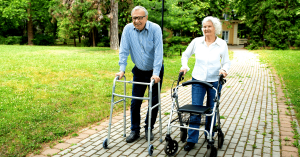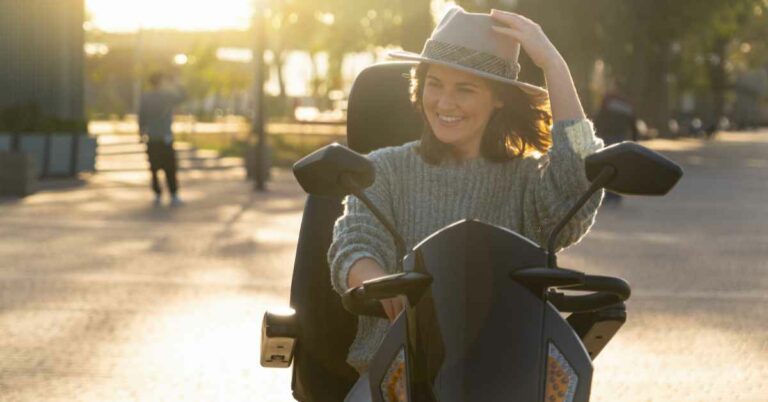
As a Physiotherapist, I have been trained to understand all the types of mobility aids available, how they differ and which is the right one for each individual person’s needs.
To simplify the subject I’ve broken down the types of mobility aids into five categories: canes, crutches, walkers, scooters and wheelchairs.
Find their pros and cons and what you need to think about when choosing one below.
Table of Contents
Toggle1. Canes
A cane (also known as a walking stick) is the least supportive type of mobility aid you can get. It can be a good starter mobility aid if you only need a little bit of help with walking and keeping steady [1].
Canes are very commonly used – some people even choose to use two! The main types are single support canes, tripod canes and quad canes.
You can read about the differences below:
Single support cane:
A single support cane is the most common type and what most people think of as a ‘regular’ cane.
It’s called a single support cane (or single point cane) as it only has one point of contact with the ground, unlike the tripod and quad canes which have three and four points of contact with the ground, respectively.

Tripod cane:
A tripod cane has three points of contact with the ground, as shown below.
This type of cane can be useful for some people who need more contact with the ground for greater support.
These canes are generally heavier to lift and carry around. But they can stand up on their own.

Quad cane:
Like the tripod cane above, the quad cane has multiple points of contact with the ground – in this case the gentleman below is actually using a quad cane in one hand and a tripod cane in the other. This can provide greater support for those who need it, for example, after a stroke [2].
He is requiring lots of support and assistance to learn to walk again.

Pros of cane use:
- Light
- Portable
- Very common – little stigma attached to using one
- Can get folding ones
- Relatively cheap
- Allows you to walk quite normally with a normal walking pattern
- You will still be working your muscles and joints and balance [3]
Cons of cane use:
- Canes don’t provide enough support for some people
- Some canes aren’t height adjustable
- Canes can sometimes put too much pressure on the wrist if it is painful anyway
- Canes can fall on the floor quite easily
- They are no use if you are restricted weight bearing (not allowed to put full weight through both your legs) – you must use a more supportive mobility aid.
What to consider when thinking about getting a cane:
- Height – is it adjustable?
- What sort of handle does it have? Will it be comfortable?
- Will you be using it all the time or just sometimes?
- Does it need to be able to fold up and go in a bag?
- Does it need to be able to stand up on it’s own?
- Is it for indoor or outdoor use or both?
- Does it need to have a seat? (Some do!).
2. Crutches
Crutches are a more supportive type of mobility aid than a cane, as they have more points of contact with the body than just at the wrist and hand.
They can also be used to offload some of your weight if you are not allowed to put full weight through your leg.
The three main types of crutches are forearm/elbow crutches, axillary/underarm crutches and gutter crutches.
You can read about the differences below:
Forearm/elbow crutches:
Forearm/elbow crutches have support around the upper forearm just below the elbow as well as at the wrist and hand.
The forearm support part of the crutch should be height adjustable as well as the overall height of the crutches.

Axillary/underarm crutches:
Axillary/underarm crutches provide support either side of your chest about 2 inches below your armpits, as well as at the wrist and hand.
The top of the crutches should not be in your armpit and you shouldn’t be putting pressure on your armpits with the crutches.

Gutter crutches:
Gutter crutches are designed for people who need to use crutches but can’t put weight through the wrist or hand.
This may be due to a wrist fracture after a fall, for example, or due to painful arthritis. The weight is taken by the forearm instead.

Pros of crutch use:
- More supportive than a cane
- Can use if you’re restricted weight bearing
- All crutches are adjustable
- Relatively cheap type of mobility aid, like canes
- Some people prefer to use crutches as they don’t look so ‘old’
- Can get crutches with comfy handles
Cons of crutch use:
What to consider when thinking about getting crutches:
- Choosing between forearm and axillary crutches
- Choosing a comfortable type of handle especially if restricted weight bearing for a longer period
- What is the weight limit of the crutches?
- How heavy the crutches are to use/move about
- Can you put weight through your wrist and hand?
- Are all parts fully and easily adjustable?
- Is it easy to find spare parts especially ferrules (rubber bottoms)?
3. Walkers
Walkers (or walking frames) are designed to be a more supportive type of mobility aid than crutches and are easier to balance with – especially for those more wobbly on their feet. Walkers, like crutches, are also designed to handle all types of restricted weight bearing.
You can get lots of different types of walkers with different names but they all essentially fall into the following categories: rollator frames, zimmer frames, gutter frames and wheeled walkers.
Rollator frame:
A rollator frame (or rollator walker) is a walker with two wheels at the front and two rubber stoppers (or ferrules) at the back.
It is the most common type of walker designed for indoor use.
The front wheels mean that the frame can be slid forward rather than the user having to lift up the frame every time they want to move forward.

Zimmer frame:
Zimmer is technically a brand name but the term zimmer frame or zimmer walker is generally used to refer to a walker with no wheels, only four stoppers.
Like the rollator walker above, it is also designed for indoor use only (despite the photo!).
No wheels means the whole walker has to be lifted before every step. This may be unsafe for users who are very unsteady on their feet or who have very weak upper body strength.

Gutter frame:
A gutter frame is a walker with a support for the forearms and is designed for people who need to use a walker but can’t put weight through the wrist or hand.
This may be due to a wrist fracture after a fall, for example, or due to painful arthritis. The weight is taken by the forearm instead, just like gutter crutches.

Outdoor wheeled walkers:
Specifically designed for outdoor use, wheeled walkers can have three or four wheels. Both types also normally have brakes and some type of attached bag for storing things.
Four wheeled walkers tend to have a seat, useful for those who tire easily and need to sit down when out and about.
These types of wheeled walkers are not designed for heavy weight bearing so you need to be able to put full weight through both your legs.

Pros of walker use:
- Generally more supportive than crutches or canes
- Walkers are more stable if you have difficulties with your balance
- Walkers are free standing – you don’t have to worry about it falling down or finding somewhere to prop it like crutches and canes
- Some walkers are folding for storage and transport
- Some walkers come with seats
Cons of walker use:
- Walkers can’t be safely used on the stairs
- Only some types of walker are for outdoor use
- Walkers are larger than crutches and canes, and therefore less portable and manouvreable
- Zimmer frames can be heavy to lift and are not suitable for those with very poor balance
- Long term use may contribute to arm aches and pains especially at the wrist [6].
What to consider when thinking about getting a walker:
- Are you restricted weight bearing? If so, this will limit what type of walker you can use.
- Will your walker be for indoor or outdoor use?
- How much space do you have to get your walker around the house, for example, through doorways? You may need to consider a narrow width walker.
- Do you have the upper body strength to lift a frame or make sure it doesn’t wheel away from you?
- What is the weight limit of the walker?
- Do you need to be able to get it in/out of a car?
- Will you need to sit down regularly when out walking with your walker?
4. Scooters
Mobility scooters obviously aren’t walking aids but they are a type of mobility aid as they allow you freedom and independence to travel!
Scooters are great if you can travel independently, get on and off a scooter by yourself and, of course, steer it safely.
They normally come in small, medium or large sizes.

General pros of scooter use:
- You can travel between 10 and 30 miles depending on the size and type of scooter
- Some scooters can be driven on the road
- They are great for independence
General cons of scooter use:
- Scooters an take up a lot of space when not being used
- They can get very expensive
- Remembering to charge your scooter!
Pros and cons of scooters by size:
Small:
- May be able to use around the home
- May be able to fold or dismantle for travel or storage
- Lower weight limit
- Shorter distance before needing battery recharge – up to 10 miles
Medium:
- Can travel further before recharge required – up to 20 miles
- Greater weight limit
- The scooter will need more space to turn around
- Harder to dismantle for travel/storage
Large:
- Can travel further before recharge – 25 to 30 miles
- Can go on roads if registered
- Larger weight limit
- Not easy to transport or store
What to consider when thinking about getting a scooter:
- Do you want to go on the road? Only some types of scooter can do this.
- Do you want to be able to dismantle it to stow it in a car boot/trunk?
- How far can the scooter go before the battery needs recharging?
- What is the scooter’s weight limit?
- How much space do you have to store it?
- Do you want to go round the house with it?
- Is it for indoor or outdoor use?
5. Wheelchairs
There are so many different wheelchairs available these days, from the standard ones mentioned below to standing wheelchairs, sport chairs, beach chairs – you name it and it exists!
Although there are thousands of different wheelchairs out there, really there are three main basic types:
Assisted/transport wheelchairs:
Transport wheelchairs have small wheels that cannot be accessed by the user and handles so the user can be pushed by an attendant.
The user has no way of moving themselves so these types of wheelchairs should only be used for people who definitely cannot move themselves – otherwise you would be restricting their freedom and independence.
Or for use for very short periods only for transport purposes.
These wheelchairs tend to be relatively cheap, fold up easily and can be stored in quite small spaces

Manual/self-propelled wheelchairs:
Self propelled (or manual) wheelchairs are designed for the user to be able to move themselves using handrims to propel the wheels (see below).
You need good enough upper body strength and stability to be able to push yourself [7]. These wheelchairs are also relatively cheap but not as cheap as transport wheelchairs. Generally you can choose the width of the seat and remove the arm rests and foot plates.
You can also get light weight and ultra light weight options if you’re struggling to push a standard chair or if you lead a very active lifestyle. The lighter the chair the more expensive it will be.

Electric/powered wheelchairs:
Electric wheelchairs are useful for people who cannot push a manual (self propelled) wheelchair. This may be due to muscle weakness, fatigue or dexterity problems [8]. You can get standard and custom power wheelchairs.
Standard ones are cheaper but can’t go as far and may struggle up hills or on rougher terrain. They are also only minimally adjustable.
Custom electric wheelchairs are more expensive, and have lots more options, for example, tilt, recline, raise up, elevate legs etc.
All electric wheelchairs are powered using chargeable battery packs.

Pros of wheelchair use:
- Provide the most support of all types of mobility aids
- Can be fully customised to your individual needs
- Can be small enough to fold, store and transport
- Provide lots of freedom and independence if you can control your own chair
Cons of wheelchair use:
- Can get very expensive
- Hard to store and transport especially custom powered chairs
What to consider when thinking about getting a wheelchair:
- Do you have the arm strength, dexterity and energy levels to push your own chair?
- Is your wheelchair for occasional or everyday use?
- Will you be able to shift your position in the chair yourself? If not, you may need one that can tilt, recline etc.
- Do you plan to use it indoors, outdoors or both?
- If outdoors, how far do you want to go in it?
- If indoors, will it fit through your doorways and hallways?
- How will you get it in and out of the house?
- What is the weight limit on it?
- Does it need to be able to fold/fit into a car boot/trunk?
- Does it need to be light enough that you can lift it yourself?
- What sort of outdoor environments do you want to be able to use it in?
- How active are you? Do you want to play sports in your wheelchair?
Ok so those are the five types of mobility aids – canes, crutches, walkers, scooters and wheelchairs.
As you can see, there are pros and cons and different things to consider for each type of mobility aid.
I hope this article has helped you to consider what options are available out there should you need some support with your mobility.
As always, it’s best to seek the advice of your healthcare professional so you know you are making the right choice and will be safe too!
In the case of mobility aids a Physiotherapist (canes/crutches/walkers) or Occupational Therapist (wheelchairs/scooters) would be your best bet.
What to do next?
Are you wondering which of the above mobility aids is right for you? If so, my quiz may be helpful:
Which mobility aid is right for you? QUIZ
Are you thinking about buying a walker but don’t know which one to choose? If so, my other quiz will provide you with a personalised recommendation:
Discover which walker or rollator is best for you – QUIZ
If you are not even sure whether you need a mobility aid at all, my article below might also be worth checking out:
References
[1] Dogru E, Kizilci H, Balci NC et al 2016 ‘The effect of walking sticks on balance in geriatric subjects’. Journal of Physical Therapy Science. Vol. 28(12) pp.3267-3271.
[2] Laufer Y. 2003 ‘The effect of walking aids on balance and weight-bearing patterns of patients with hemiparesis in various stance positions’. Physical Therapy. Vol 83(2) pp.112-22.
[3] Haddas R, Lieberman IH, Singh Kakar R 2019 ‘A Comparison of Muscular Activity During Gait Between Walking Sticks and a Walker in Patients With Adult Degenerative Scoliosis’, Spine Deformity,
Vol 7, Issue 3, pp 454-466
[4] Chang, I. T. and Hohler, A. D. 2012 ‘Bilateral Radial Nerve Compression (Crutch Palsy): A Case Report’, Journal of Neurology & Neurophysiology, vol. 3, issue 3, p 130
[5] Borrelli J, Haslach HW Jr. 2013 ‘Experimental characterization
of axillary/underarm interface pressure in swing-through crutch walking’, Journal of Rehabilitation Research & Development, vol. 50, no. 3, pp. 423–36.
[6] McQuade KJ, Finley M, Oliveira AS. 2011. ‘Upper extremity joint stresses during walkerassisted ambulation in post-surgical patients’. Revista Brasiliera Fisioterapia. Vol.15(4), pp. 332-7
[7] Moon HB, Park SJ, Kim AC, et al. 2013. ‘Characteristics of upper limb muscular strength in male wheelchair tennis players’. Journal of Exercise Rehabilitation. Vol 9(3) pp. 375-80.
[8] Frank AO, De Souza LH. 2018. ‘Clinical features of children and adults with a muscular dystrophy using powered indoor/outdoor wheelchairs: disease features, comorbidities and complications of disability’. Disability Rehabilitation. Vol 40(9), pp. 1007-1013









